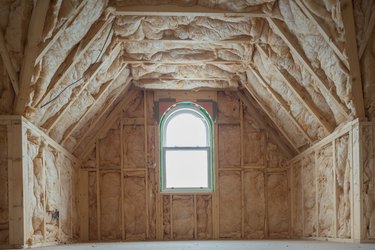
To design comfortable and ecologically sound buildings, architects and engineers make use of the thermal properties of materials. Different building materials have different conductivities, meaning that they let heat flow through them differently. High conductivity, K, indicates rapid heat flow, and low conductivity indicates low heat flow. Thicker pieces of the same material cause heat to flow more slowly than thin pieces. So actual thermal performance depends on both the conductivity and the thickness of the material. A piece of material with a conductivity K and thickness L has a conductance of C = K/L, which indicates how well heat can flow through a specific piece of that material such as a wall. In buildings, you are often concerned with stopping heat flow, or insulating. The insulating value of an object is called the R-value and can be calculated as R = 1/C = L/K.
Calculating the R-Value of a Concrete Slab
Video of the Day
Step 1
Look up the conductivity, K, of concrete in a table such as that in resource 1. Light concrete can have a conductivity as low as 0.1 watts per meter-kelvin, making it a good insulator. The denser the concrete gets, the more conductive it is to heat. Dense concrete can have a conductance as high as 1.8 watts per meter-kelvin. Assume the slab is made of dense concrete with a conductance of 1.2 watts per meter-kelvin.
Video of the Day
Step 2
Determine the thickness of the material and convert to meters. Assume a 12-inch-thick slab, which is equivalent to 0.305 meters. Heat would have a harder time flowing through a thick slab than a thin slab. Label the thickness L.
Step 3
Calculate the conductivity. The conductivity of the slab increases with conductance and decreases with thickness. The conductivity for the slab is C = K/L = 1.2/0.305 = 3.93 watts per meter^2-kelvin.
Step 4
Calculate the R-value by taking the reciprocal of the conductivity C to get R = 1/3.93 = 0.254 kelvin-meter^2/watt. You can also calculate the R-value directly as R = L/K = 0.305/1.2 = 0.254 kelvin-meter^2/watt. Notice that the thicker the material is, the higher the R-value is. More of a given material makes a better insulator.